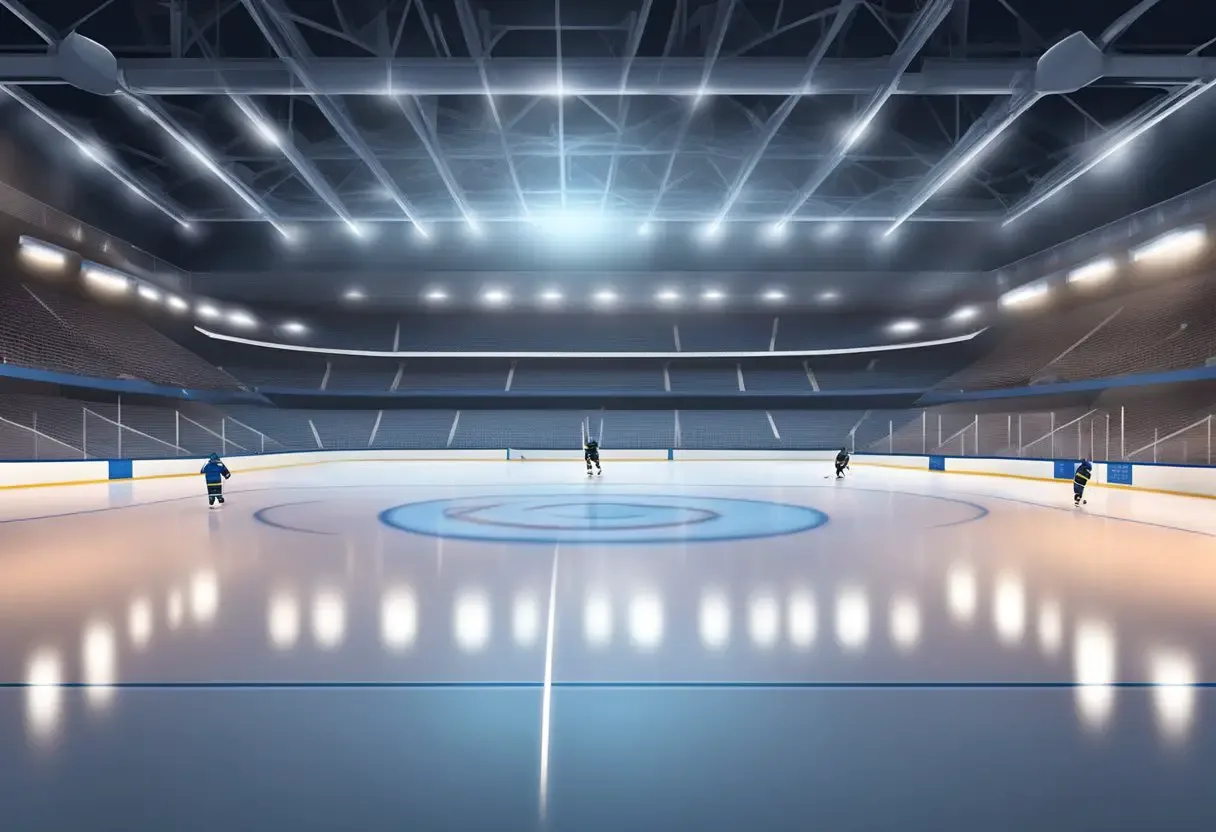The thickness of the ice on a hockey rink varies depending on it’s use and whether it is indoors or outdoors.
In the NHL, the thickness of the ice is about 3/4 of an inch thick.
Ideal ice provides a smooth, stable surface that allows players to glide easily, controlling their movements and the puck with precision.
The thickness is not arbitrary; too thin, and it risks player safety; too thick, and the puck movements slow down, affecting play quality.
The ice thickness in a hockey rink varies slightly but typically ranges from about three-quarters of an inch to an inch and a half.
At a professional level, including NHL games, the ice tends to be approximately 3/4 of an inch thick.
This balance is maintained meticulously to ensure the surface is suitable for the high-speed demands of the sport while resisting damage from the skates and gear of the players.
Maintaining rink ice involves careful temperature control and a multi-step process.
The ice must remain solid despite the friction and heat generated by intense activity.
For fans and players alike, the ice’s composition is just as important as the game played on it, demonstrating the intricate intersection of sport and science.
Understanding Ice Thickness in Hockey Rinks

In professional hockey leagues like the NHL, the ice thickness is an essential aspect of the rink that affects the game.
Standard thickness for these rinks is generally around 0.75 inches (about 19.05 millimeters or 1.905 centimeters).
This precise measure of thickness is crucial to maintain the quality and performance of the playing surface.
Ice thickness can vary depending on the type of rink.
While NHL and other professional arenas maintain a thinner layer, outdoor rinks often require a thicker surface.
For instance, some outdoor community rinks can have ice as thick as 6-8 inches due to environmental factors like temperature and weather conditions.
Refrigeration Systems
Behind the scenes, advanced refrigeration systems work diligently to control the freezing process.
This technology, combined with a concrete floor beneath the ice, ensures a consistent and optimal playing surface.
Hockey rinks have specific requirements for ice quality, and controlling the temperature within the arena is key.
The maintenance team routinely measures the ice to ensure it meets the necessary standards.
Factors That Affect Ice Quality
Several factors contribute to ice quality, including the technology behind the rink’s refrigeration system and the environmental conditions both inside and outside the arena.
A rink’s ice must withstand the force of players and the speed of the game, making its maintenance a precise science.
Thickness Measurement
It’s interesting to note that the thickness of the ice is actually thinner than the hockey puck used in the game.
Regular checks and measures are carried out to make sure that the ice remains within the standard thickness range for optimal play.
Optimizing Ice Conditions for Performance and Safety
In the fast-paced game of hockey, the quality of ice plays a vital role in player performance and safety.
Proper maintenance ensures safe and optimal playing conditions.
The ice surface in a hockey rink requires a balanced temperature, typically between 19-22 degrees Fahrenheit.
The refrigeration system of an arena works together with temperature control protocols to freeze the water evenly, avoiding melt spots that can affect gameplay.
Regular maintenance is crucial, with professionals often using a Zamboni to clean and smooth the ice, ensuring that it remains safe for players to skate at high speeds.
The Relationship Between Ice Quality and Gameplay
NHL games demand high-quality ice to enable quick turns, smooth passes, and fast puck movement.
If ice isn’t kept at the standard thickness, it can impact the speed and control players have over their equipment, affecting the performance during a fast-paced game.
An even and well-maintained ice rink is key to the flow of the game and the safety of players.
Safety Measures and Rink Standards
Player safety is paramount, and rink standards are set to minimize injuries.
The NHL and other organizations enforce regulations for not just the ice surface but also the surrounding boards, glass, and faceoff circles to protect players and fans alike.
Safety measures include the proper upkeep of markings, the crease, and transparent barriers to accommodate physical play and dynamic skating without compromising visibility or safety.
Frequently Asked Questions

The thickness of the ice on a hockey rink is a key component to the quality of play.
It varies from place to place but has standard guidelines especially for professional sports.
What is the standard thickness of NHL rink ice?
In the NHL, the ice typically measures around ¾ of an inch thick.
This allows for a balance between speed, temperature control, and the safety of the players.
How is ice installed and maintained in indoor arenas?
The installation and maintenance of ice in an indoor arena involves layering water over a cooled concrete surface.
This process is regulated carefully to ensure consistency and smoothness. Machines like Zambonis resurface the ice to repair skate marks and maintain optimal conditions.
What are the dimensions of an Olympic-size hockey rink?
An Olympic-size hockey rink measures 60 meters by 30 meters.
This size is used for international competitions and is larger than the typical NHL size.
How does a Zamboni machine work to resurface ice?
A Zamboni cuts a thin layer off the top of the ice, collects the shavings, washes the surface, and then lays down a layer of clean water that freezes to form a smooth surface.
What structure is found beneath the ice of a hockey rink?
Beneath the ice, there is usually a concrete slab that houses a network of pipes filled with a cooling agent. These pipes help maintain the ice’s temperature and keep it solid.
What guidelines are there for the thickness of ice in a backyard rink?
For backyard rinks, ice should be at least 3 inches thick to support the weight of skaters.
The size and usage will determine if more thickness is necessary.

